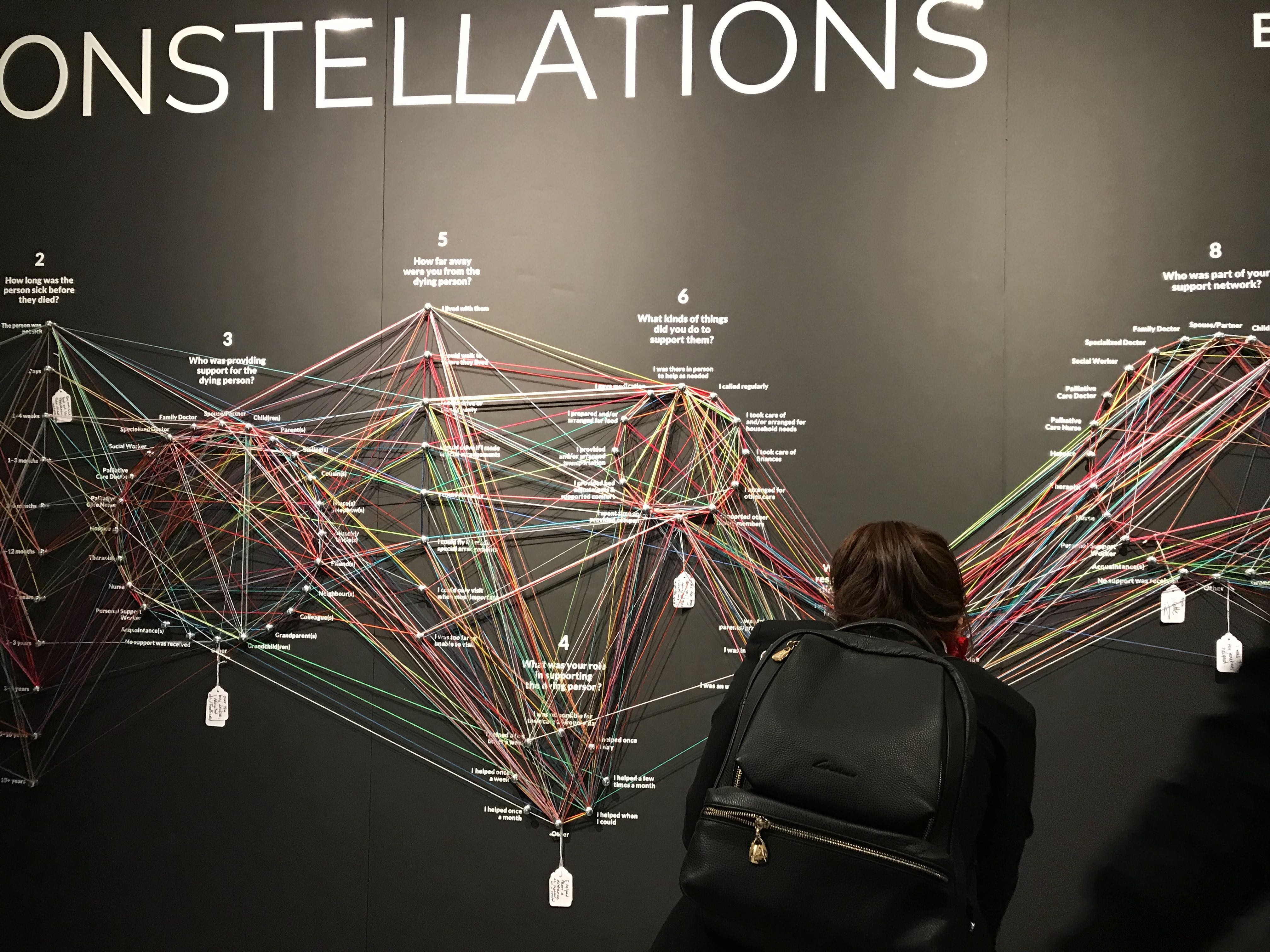Design Research is a powerful tool, but we must take it a step further by meeting people where they're at to build empathy and deliver better outcomes.
With great power, comes great responsibility. As designers, we have the power to design change. We also have a responsibility to connect with people in honest and meaningful ways—to design with, not only for, others. We must ensure people are at the centre of our designs. Design Research is a key method to make this happen, but the value is only realized when we truly meet people where they’re at to uncover the necessary information that ultimately informs our designs.
In Design Research, we engage participants early, often, and in manners that are sensitive to their experiences and context. These methods, whether interviews, observations, group workshops, or probes, provide opportunities to meet people where they’re at, and to consider their needs, whatever the circumstances.
The result? We connect with users in authentic and sensitive ways, we discover rich insights that may otherwise go unnoticed, and we surface design possibilities with the opportunity to create real impact.
5 ways design research can meet people ‘where they’re at.’
How might we put this principle of ‘meeting people where they’re at’ into action? Here are five ways to be aware and adapt to various vulnerabilities and needs to help ensure your process is kind, ethical, and insightful—and to ultimately create better human-centered experiences.
1. Meet people in their surroundings.
What we mean: If it’s suitable and welcome, join folks in their own space. Odds are, there is a lot to learn from the context, and they’ll feel more comfortable to share openly, resulting in more learnings.
Why it’s useful: The added context from their environment will often reveal unexpected learnings that you may not have anticipated, or would not have even known to inquire about in the first place. Whether it’s a ping from their phone, the activities that happen in their spaces, other people sharing the space, or their body language, you may be surprised by what you can learn by being immersed in your client’s normal environment.
How we’ve used it: In a recent project, we analyzed people’s experience while moving houses. By shadowing people as they packed up their belongings, hired a truck, entered their new home, and then unpacked, common challenges among households were quickly revealed. This highlighted potential service design opportunities to ease the moving headache, and it was as simple as following along for a day.
2. Meet people with the language they use.
What we mean: Language is fascinating because it can be hugely effective at building both bridges and barriers. By using language and lingo that others aren’t familiar with (yes, designers, we can be guilty of using our own fancy lingo!) we risk making people feel uncomfortable or unable to contribute candidly. This, in turn, limits our potential learnings.
Why it’s useful: Adopting the language and lingo of those you’re designing with is an effective means of building trust and fostering a sense of ease. This creates a welcoming baseline that is accessible for all, and goes a long way to gaining candid contributions from participants.
How we’ve used it: When introducing employee teams to human-centered design (HCD) practices, we prototyped beginner guides using plain language. For example, to describe HCD methods, we replaced terms like ‘ideate’ with more mainstream terms like ‘brainstorm’ and ‘exploring ideas.’ By moving away from designer language—i.e. ideate—toward a more inclusive language, we built bridges with terms people were already more familiar with.
With our door open to anyone that wanted to drop by, we were able to connect with people ahead of the official project kickoff. The welcoming and private space encouraged people to share more directly and transparently than we expected, providing extra context…
3. Meet people in their community.
What we mean: In some situations, where there are contentious issues or challenging dynamics between groups, it is essential to recognize the moments where people may not feel equally able or inclined to participate. If these go unrecognized or unaddressed, the design process risks poor engagement and potentially misses critical and balanced dialogue. It is, therefore, imperative to meet people in their communities.
Why it’s useful: This helps ensure that different groups are represented equally and provides a more accurate perspective into what is going on.
How we’ve used it: On a recent corporate engagement, tensions among employees were high. We were cautioned that outside consultants were associated with ‘efficiencies’ (aka layoffs) by many people within the company. Mindful that we didn’t want to seem like we were only representing the senior leadership’s perspective, we made arrangements to have a space to work onsite. With our door open to anyone that wanted to drop by, we were able to connect with people ahead of the official project kickoff. The welcoming and private space encouraged people to share more directly and transparently than we expected, providing extra context about the organization for when we’d really roll our sleeves up to help design the best solutions for the humans at the centre of our design—in this case, the employees!
4. Meet people at their level of experience when collaborating.
What we mean: On projects, we often ask our clients and participants to jump into unfamiliar and sometimes uncomfortable ways of working. In many cases, it’s their first time engaging with design thinking methods. We keep this top of mind and empathize with how it feels to be involved with design thinking methods for the first time and what their needs might be. For example, we might employ warm-up sketches before we break out the pipe cleaners, or go through some exercises and design process ‘101’, before asking folks to jump directly into an intense sticky note exercise. It’s all about ensuring the people we’re collaborating with feel comfortable and can participate at their level, whatever level that may be.
Why it’s useful: This consideration sets our client teams up to participate more effectively, and in turn, better positions us to get at the heart of uncovering the right information. Their organizational knowledge and experience is then shared directly in the process (i.e. ideation, co-creation, synthesis) rather than via decks or presentations. By meeting people at their experience level, we gain contributions more effectively and enhance the thinking earlier in the process, enriching the outcomes throughout. And here’s a bonus: as our clients’ innovation capabilities build throughout the project, their experience level increases, which, in turn, creates a more effective partnership to build better outcomes.
How we’ve used it: Using The Moment’s Joined Up Team model, we pair client team members holding organizational knowledge with The Moment Innovation Designers who hold expertise in the innovation process. The goal is to guide our clients in the work, all the while helping them to build innovation capabilities so they’re set up for success long after we’re gone. We’ll share theory decks, do practice exercises, and adapt our process to ensure we have our team with us along the way. This has provided invaluable organizational perspective that helps set up the work in a realistic and implementable way.

A participant expresses their experience with death at the Constellations Exhibit at DesignTO 2019.
5. Meet people where they’re at emotionally.
What we mean: In some scenarios, we may find our participants are experiencing something that is difficult to navigate, which sometimes creates a barrier that we need to be sensitive to as we ask them to trust us and to share their experience. In scenarios where engagement may be difficult or trying for participants, it is valuable to consider what they get in exchange.
Why it’s useful: By sensing and acknowledging emotional challenges, we’re able to design for it. We can be deliberate in getting them to feel at ease, designing the participation to suit their needs and engaging them more graciously.
How we’ve used it: In a public exhibition at DesignTO, Constellations looked to gather stories and experiences from people that have lost a loved one. The experience was designed to be sensitive, cathartic, kind, available when the participant was ready, and was both public and confidential. Participants in the exhibit later told us that they appreciated the participatory experience because they were able to contribute when they felt ready, and were able to share as much or as little as they felt comfortable with.
Design Research is a privilege; it allows us to interact on a very personal level with the people with whom—and for whom—we are designing. It is therefore incumbent upon us as designers to include participants in the most authentic way possible: by meeting them where they’re at, in levels of experience, emotional connection, in their communities and surroundings, and by using language they understand and can relate to. This is how we become better designers, and ultimately, create better outcomes for those we serve—the humans at the centre of our designs.
Assess your innovation capabilities.
Design Research is part of a larger set of Innovation Capabilities that help designers guide their teams and organizations from where they are now to where they need to be tomorrow. Assess your unique combination of capabilities and experiences in the 12 core competencies of Innovation Design with our Innovation Designer Capability Map.









